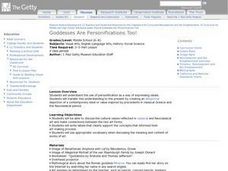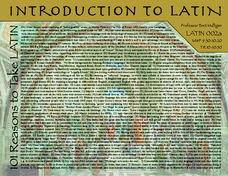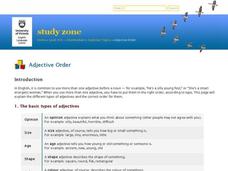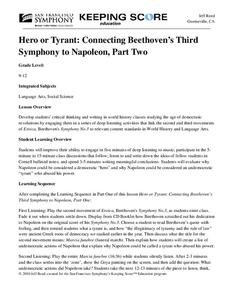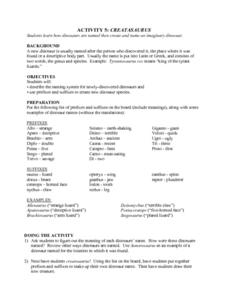Curated OER
War and International Law: A Brief History of the Law of War
Students investigate the history of the law of war. In this international law lesson, students listen to a lecture regarding the history of international law spanning from Pax Romana to Collective Security. Students respond to...
Curated OER
History Quiz 67
In this history worksheet, students take a multiple choice quiz about the geography of famous empires. Students complete 4 multiple choice questions.
Curated OER
Goddesses are Personifications Too!
Students analyze the use of personification in classical Greek art and the Neoclassical period. In this Neoclassical art lesson, students discuss the cultural values reflected in classical and Neoclassical....
Curated OER
Introduction To Latin
In this language arts worksheet, students examine the 101 reasons for taking a class in Latin. The syllabus has classical art for background on the cover page.
University of Victoria
Introduction to Adjective Order
Here is an online teaching tool that you can use to help fourth graders understand the proper ordering of adjectives. An explanation is given for eight different types of adjectives in addition to guidelines about how to order them. This...
Curated OER
Introduction to Greek Theater and Antigone
Students produce a bulleted list of five facts about Greek Theater, complete the comparison graphic of Greek Theater Web sites, and create a bulleted list of four major themes.
Curated OER
Hieroglyphics: It's Not Greek To Me! (It's Egyptian)
Students identify different hieroglyphic characters. They spell their name and write a sentence using them. They use online hieroglyphic translators as well.
Curated OER
Mother's Day: History
For this reading comprehension worksheet, 6th graders read a 7-paragraph essay about the history of Mother's Day. Students then answer 7 multiple choice questions about the passage.
Curated OER
Veni, Vidi, Vici
Students participate in a Roman festival to complete a unit on Roman Civilization. In this Roman Civilization lesson plan, students learn about Cleopatra, Julius Caesar, the Mediterranean Region, and more. Students share what they...
Curated OER
Mythical Beasts
Students explore literature and art forms containing creatures that are part human and part animal, such as the Greek Sphinx, Neptune, or the Green Centaur. Individually, students write a poem or short story to create a character with...
Curated OER
Medicine Through Time Giant Crossword
In this recognizing the history of medicine crossword instructional activity, students use the across and down clues to review medicine, diseases, and people through time. Students write 31 answers.
Curated OER
Icons
Students compare the characteristics and values depicted in ancient wall decorations with art displayed in contemporary rooms. They recognize and articulate the heroic qualities represented by the Fallen Warrior sculpture.
Curated OER
Ceramics: A Vessel into History
Students create a ceramic vessel, discuss their artistic choices, and identify elements derived from historical examples. In this ceramics lesson, students identify symbols and imagery that are connected to a specific...
Curated OER
The Games Divided
In these Olympic history worksheets, students read about the ancient Olympic games and the modern games. Students complete a Venn diagram to compare and contrast the past and present Olympic games.
Curated OER
The Art of Imitation: Writing an Aristotelian Tragedy
Students, after exploring the history of tragedies and analyzing Aristotelian elements in Greek/Roman tragedies, create their own tragedy set in modern context. They formulate their creations from an Aristotle platform. In addition, they...
Curated OER
Rooting One's Way To Meaning
Young scholars use a thesaurus on the internet to explore the meanings of Greek and Latin roots. They find definitions of given words, draw a concept map for root words, and write four synonyms for each word. Students discover how Latin...
Curated OER
It's All in the Translation
High schoolers compare and contrast translations of Greek literature. In this dramatic literature lesson, students read and perform passages from four different translations of Euripides's Hecuba. High schoolers discuss how the...
San Francisco Symphony
Hero or Tyrant: Connecting Beethoven’s Third Symphony to Napoleon, Part Two
Was Napoleon a tyrant or a hero? Answers could vary depending on the political point of view. Learners listen to Beethoven's Symphony #3 while considering Napoleon's undemocratic tyranny. They listen to the piece in five parts, each time...
Curated OER
ESL Holiday Lessons: National Yo-Yo Day
In this language skills instructional activity, students read an article on National Yo-Yo Day. Students respond to 6 matching questions, 29 fill in the blank questions, 30 multiple choice questions, 12 word scramble ...
Curated OER
Creatasaurus
Upper elementary children still are intrigued by dinosaurs. Here is a dinosaur lesson that is geared toward their age group! The learners consider a list of prefixes and suffixes. Using the list, they can analyze the names of their...
K12 Reader
Basic Geometry Terms
Set your pupils up to start on geometry by teaching them some introductory terminology. Pupils learn the terms by reading a short passage and looking at examples. They then respond to five questions related to the text.
Curated OER
Tools of Persuasion
Ethos, pathos, and logos. After reading a passage about Aristotle's, three basic tools of persuasion, individuals answer a series of multiple choice comprehension questions and craft responses to three short-answer essay prompts.
E Reading Worksheets
Fact and Opinion - Worksheet: 5
After reading 25 sentences, individuals decide if they are facts or opinions. Then, they explain their answer in a supporting sentence.
Curated OER
Sparta and Athens
Sixth graders study Ancient Greece. For this Ancient Greece lesson, 6th graders complete 16 lessons to learn about Ancient Greece. Students complete a quiz for assessment.




